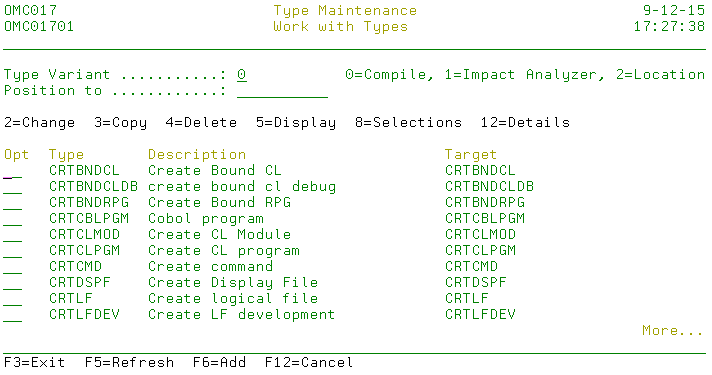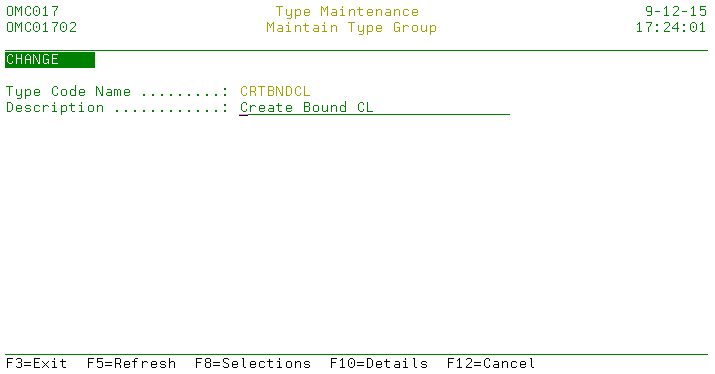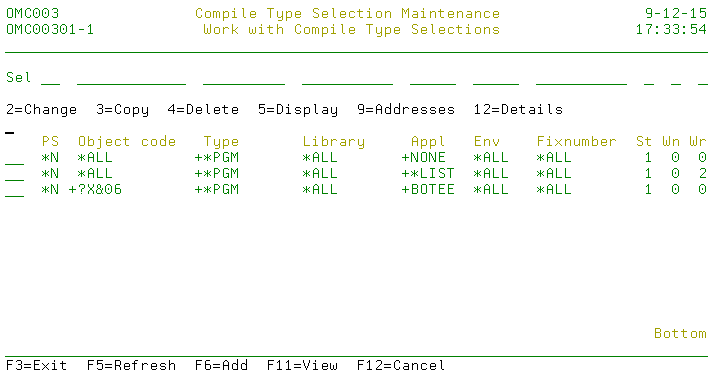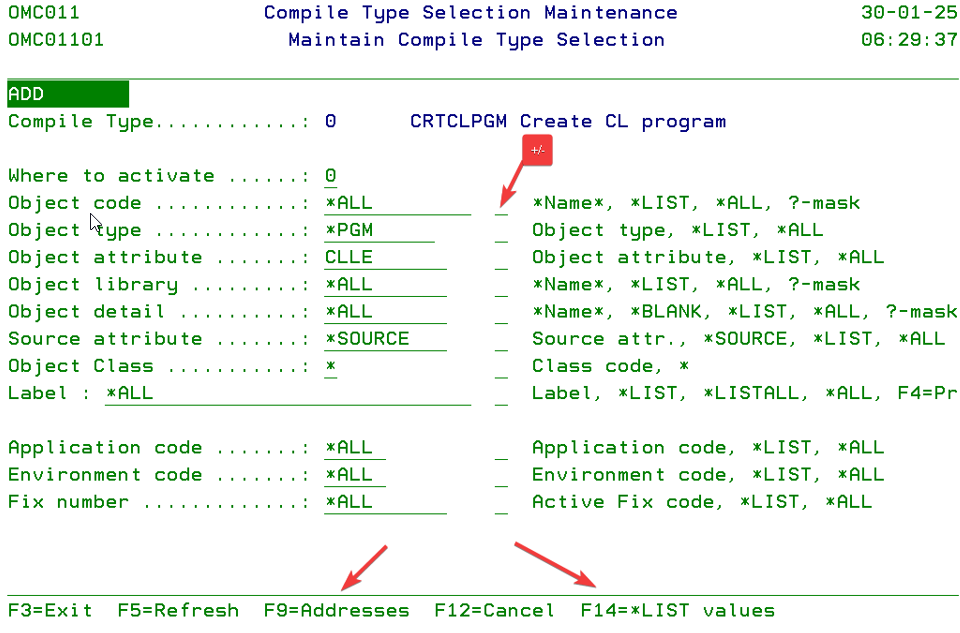DFG:Type Maintenance
Type Maintenance
The Type Maintenance function can be used to add, change and delete Types. With this function, only the basic characteristics of a Type are maintained. However, from within this function the associated maintenance programs can be started.
Work with Types
The Work with Types display shows the Types for the currently selected Type Variant. You can change the Type Variant or you can add an entry to the list, remove an entry from the list, copy a Type code or change the Type definition and/or its details. You can also add a selection to the Type to determine the objects for which the types are valid.
Type Variant
This indicator controls the display for which type definitions are displayed. The possible values are:
- 0=Compile Type
- Use this code to change the details of Compile Types.
- 1=Impact Analyzer Type
- Use this code to change the details of Impact Analyzer Types.
- 2=Location Type
- Use this code to change the details of Location Types.
Position to
Use this field to position the list.
Options and Function keys
Use this column to perform different operations on individual entries. The possible values are:
- 2=Change
Change the basic definitions of a Type. - 3=Copy
Copies an existing Type, including its details but not its selections, to a new Type. - 4=Delete
Deletes the Type including its details and selections. - 5=Display
Shows the basic definitions of a Type. - 12=Work with Deails
Type 12 to work with the detail definitions of a Type. - F6=Add
Add a new Type of the currently active Variant.
Maintain Type
The Maintain Type display enables you to change the basic definitions of a type. The type of information you can changed depends on the chosen Type Variant. The Display shows any of 5 modes:
- Add
Used to add a new Type definition. The Type code and the description must be entered. In case of an Impact Analyzer code you also must add the Impact Analysis report code. - Change
You can change the description and, in case of an Impact Analyzer Type, the Impact Analysis report code. - Copy
All the fields will be copied from the current Type to a new entry definition. - Delete
The current Type header entry will be shown, including a confirmation message. Type details defined for this Type header also will be deleted.
- Function Keys
- F8=Selections
Jump to the selections of this type - F10=Details
Jump to the details of this Type (Compile Type only)
Note: For more information about a specific attribute move the cursor to the attribute area and press Help.
Type Name
The short name of the Type.
Description
A longer more meaningful description of the Type.
Report Code
In case of an Impact Analyzer Type you must select an IA report code.
Work with Type Selections
The Type Selection Maintenance screen enables you to add selections for this Type. You have to determine for which objects this type is valid. It is possible that an object is selected by Multiple selections. If this is the case then a Type Selection Rule will determine which Type is actually valid for the Object. Any object ever only has zero or one associated Type.
This screen displays a list of the currently existing selections. You can use the option field to maintain these selections, or you can press F6 to add a new selection.
You can use the selection fields at the top of the screen to select only those selections that meet the selection criteria. This can be helpful if there are many.
If a specific value is used in an action selection, then the value is preceded by a '+' sign or a '-' sign. A '+' indicates that if the run-time value is equal to the value in the selection, then the related selection is valid. A '-' indicates that the related selection is valid if the run-time value is not equal to the value in the selection.
To associate the Type with and object or detail, one or more of the selections must match the object.
Option
The possible values are:
- 2=Change
change the environment code or the continue processing indicator of the connection rule detail. - 3=Copy
copy an existing connection rule detail. - 4=Delete
delete an existing connection rule detail. - F6=Add
Add connection rule details
Maintain Type Selection
The Maintain Type Selection display enables you to define a selection for the type code.
The display operates in any of these four modes:
- Add
You can add a new entry. - Change
You can change an entry. - Copy
The entry is copied to a new entry. - Delete
Here you confirm the deletion of an entry. - Display
You an view the entry but not change it.
- Function Keys
- F9 to associate addresses or remote machines to this selection and F14 to define list values
Where to Activate
If available, this field determines if the Type is active on this system, on a remote system or both. If you want to execute this Type on a remote system then you also need to supply the addresses where the Type must be distributed to. Press F9 to define the addresses.
- 0=Local
- This Type is active on the local machine.
- 1=Remote
- This Type is active on a remote machine. Use F9 to define the addresses of the remote machines.
- 2=Both
- This Type is active on the local machine and on remote machines. Use F9 to define the addresses of the remote machines.
Object Code
This entry lets you define the name of the object for which this type must be selected (+) or not (-).
- Name
- Selects all objects with this name (+) or all objects that don't have this name (-).
- Name*
- Selects all objects with the first letters of the name (+) or selects all objects that don't have this name (-).
- *LIST
- Selects all objects with names defined in the list (+) or selects all objects NOT in this list (-). Press 'F14' to define the list.
- *ALL
- The name does not play a part in the selection.
- ?-Mask
- Selects all objects with names matching the mask ORD???FM to select all objects starting with ORD and ending with FM (+). If you use (-) all objects are selected that do not match the mask.
Object Type
This entry lets you define the object type for which this type must be selected (+) or not (-).
- Object Type
- Selects all objects of the entered type (+) or all objects that don't have this type (-)
- *LIST
- Selects all objects of the type in the associated list (+) or all objects with types not in this list (-). Press F14 on the field to define list values.
- *ALL
- Object Type selection is not active.
Object Attribute
This entry lets you define the object attribute for which this type must be selected (+) or not (-).
- Object Attribute
- Selects all objects with the entered attribute (+) or all objects that don't have this attribute (-)
- *LIST
- Selects all objects of the attribute in the associated list (+) or all objects with attribute not in this list (-). Press F14 on the field to define list values.
- *ALL
- Object Attribute selection is not active.
Object Library
This entry lets you define the object library for which this type must be selected (+) or not (-).
- Object Library
- Selects all objects with the entered library (+) or all objects that are not in this this library (-)
- *LIST
- Selects all objects of the library in the associated list (+) or all objects in a library not in this list (-). Press F14 on the field to define list values.
- *ALL
- Object library selection is not active.
Object Detail
If you process an object that is a detail (i.e. a single message or a source member) and you want to process a special type then you can use this selection.
- Detail code
- Selects all details with the entered name (+) or all details do not have this name (-)
- Name*
- Selects all details with the first letters of the name (+) or selects all objects that don't have this name (-).
- *LIST
- Selects all details with the name in the associated list (+) or all details not in this list (-). Press F14 on the field to define list values.
- *BLANK
- Select the object if it does not concern a detail (+) or when it does concern a detail (-)
- *ALL
- Object Detail selection is not active
- ?-Mask
- Selects all details with names matching the mask ORD???FM to select all objects starting with ORD and ending with FM (+). If you use (-) all details are selected that do not match the mask.
Detail Attribute
This field has a double meaning. If you process an object that is a detail (i.e. a single message or a source member) then the field pertains the member name or message id. If you process an object that is not a detail (i.e. a program, a physical file, a logical file or a display file) then the field pertains the associated source of the object.
When processing a single message or source member
- Detail Attribute
- Selects all details with the entered attribute (+) or all details that do not have this attribute (-)
- *LIST
- Selects all details with the attribute in the associated list (+) or all details with attributes not in this list (-). Press F14 on the field to define list values.
- *ALL
- Detail Attribute selection is not active
When processing other objects then a single message or source member
- Detail Attribute
- Selects all objects with the source attribute that matches the entered attribute (+) or all objects with a source attribute that do not have this attribute (-)
- *LIST
- Selects all objects with the source attribute that matches the entered attribute in the list (+) or all objects with a source attribute that do not have this attribute in the list (-). Press F14 on the field to define list values.
- *ALL
- Detail Attribute selection is not active
Object Class
Defines the class of the object. This is the internal TD/OMS object class.
- Class Code
- Selects all objects with the selected class (+) or all objects not of the selected class (-)
- *
- Object Class selection is not active
Label
Defines the label of the object.
- Label
- Selects all objects associated with this label (+) or all objects not associated with this label (-)
- *LIST
- Selects all objects associated with this label in the list (+) or all objects not associated with this label in the list (-). Press F14 on the field to define list values.
- *ALL
- Label selection is not active
- F4
- Press F4 on the field to select the label.
Application Code
Defines the application code of the object.
- Application code
- Selects all objects in this application code (+) or all objects not in this application (-)
- *LIST
- Selects all objects in applications in the list (+) or all objects not in applications in the list (-). Press F14 on the field to define list values.
- *ALL
- Application code selection is not active
Environment Code
Defines the environment code of the object. During transfer it defines the environment where the object is transferred to. During in place compilation it is the environment the object is in.
- Environment code
- Selects all objects in this environment code (+) or all objects not in this environment (-)
- *LIST
- Selects all objects in environment in the list (+) or all objects not in environment in the list (-). Press F14 on the field to define list values.
- *ALL
- Environment code selection is not active
Fix (Task) number
Defines the Fix/Task the object is attached to.
- Active Fix/Task Code/Number
- Selects all objects in this task (+) or all objects not in this task (-)
- *LIST
- Selects all objects in tasks in the list (+) or all objects not in tasks in the list (-). Press F14 on the field to define list values.
- *ALL
- Task code selection is not active
Command Start Type Maintenance (STRTCM)
This menu command starts the object maintenance function. This command has one parameter.
STRTCM TYPI(*COMPILE|*LOCATION|*IMPACT)
Type Variant (TYPI)
Specify the Type Variant to be maintained. Once you started maintaining a Type, you are also able to select another Type Variant for maintenance. Specify one of the following types:
- *COMPILE: Specifies that the compile types are to be maintained.
- *LOCATION : Specifies that the location types are to be maintained.
- *IMPACT : Specifies that the impact analyzer types are to be maintained.




